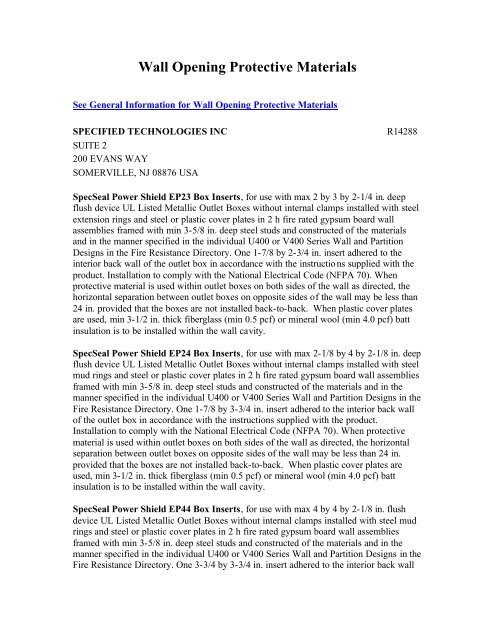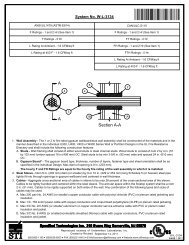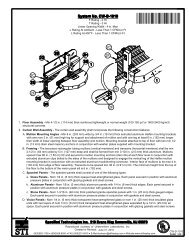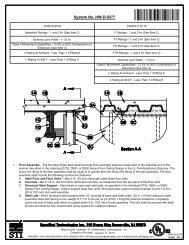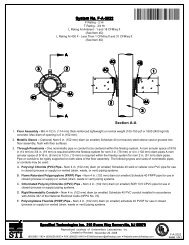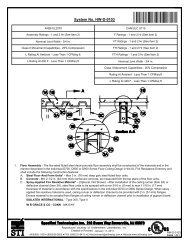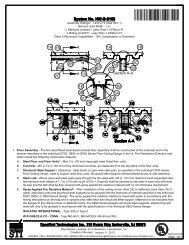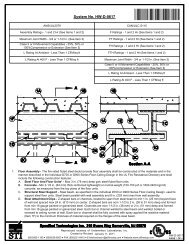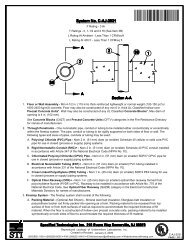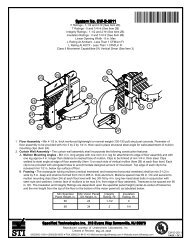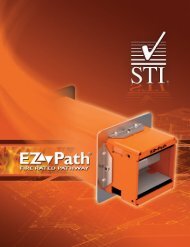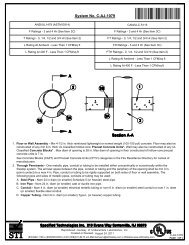R14288 cliv - STI - Specified Technologies Inc
R14288 cliv - STI - Specified Technologies Inc
R14288 cliv - STI - Specified Technologies Inc
Create successful ePaper yourself
Turn your PDF publications into a flip-book with our unique Google optimized e-Paper software.
Wall Opening Protective Materials<br />
See General Information for Wall Opening Protective Materials<br />
SPECIFIED TECHNOLOGIES INC<br />
SUITE 2<br />
200 EVANS WAY<br />
SOMERVILLE, NJ 08876 USA<br />
<strong>R14288</strong><br />
SpecSeal Power Shield EP23 Box Inserts, for use with max 2 by 3 by 2-1/4 in. deep<br />
flush device UL Listed Metallic Outlet Boxes without internal clamps installed with steel<br />
extension rings and steel or plastic cover plates in 2 h fire rated gypsum board wall<br />
assemblies framed with min 3-5/8 in. deep steel studs and constructed of the materials<br />
and in the manner specified in the individual U400 or V400 Series Wall and Partition<br />
Designs in the Fire Resistance Directory. One 1-7/8 by 2-3/4 in. insert adhered to the<br />
interior back wall of the outlet box in accordance with the instructions supplied with the<br />
product. Installation to comply with the National Electrical Code (NFPA 70). When<br />
protective material is used within outlet boxes on both sides of the wall as directed, the<br />
horizontal separation between outlet boxes on opposite sides of the wall may be less than<br />
24 in. provided that the boxes are not installed back-to-back. When plastic cover plates<br />
are used, min 3-1/2 in. thick fiberglass (min 0.5 pcf) or mineral wool (min 4.0 pcf) batt<br />
insulation is to be installed within the wall cavity.<br />
SpecSeal Power Shield EP24 Box Inserts, for use with max 2-1/8 by 4 by 2-1/8 in. deep<br />
flush device UL Listed Metallic Outlet Boxes without internal clamps installed with steel<br />
mud rings and steel or plastic cover plates in 2 h fire rated gypsum board wall assemblies<br />
framed with min 3-5/8 in. deep steel studs and constructed of the materials and in the<br />
manner specified in the individual U400 or V400 Series Wall and Partition Designs in the<br />
Fire Resistance Directory. One 1-7/8 by 3-3/4 in. insert adhered to the interior back wall<br />
of the outlet box in accordance with the instructions supplied with the product.<br />
Installation to comply with the National Electrical Code (NFPA 70). When protective<br />
material is used within outlet boxes on both sides of the wall as directed, the horizontal<br />
separation between outlet boxes on opposite sides of the wall may be less than 24 in.<br />
provided that the boxes are not installed back-to-back. When plastic cover plates are<br />
used, min 3-1/2 in. thick fiberglass (min 0.5 pcf) or mineral wool (min 4.0 pcf) batt<br />
insulation is to be installed within the wall cavity.<br />
SpecSeal Power Shield EP44 Box Inserts, for use with max 4 by 4 by 2-1/8 in. flush<br />
device UL Listed Metallic Outlet Boxes without internal clamps installed with steel mud<br />
rings and steel or plastic cover plates in 2 h fire rated gypsum board wall assemblies<br />
framed with min 3-5/8 in. deep steel studs and constructed of the materials and in the<br />
manner specified in the individual U400 or V400 Series Wall and Partition Designs in the<br />
Fire Resistance Directory. One 3-3/4 by 3-3/4 in. insert adhered to the interior back wall
of the outlet box in accordance with the instructions supplied with the product.<br />
Installation to comply with the National Electrical Code (NFPA 70). When protective<br />
material is used within outlet boxes on both sides of the wall as directed, the horizontal<br />
separation between outlet boxes on opposite sides of the wall may be less than 24 in.<br />
provided that the boxes are not installed back-to-back. When plastic cover plates are<br />
used, min 3-1/2 in. thick fiberglass (min 0.5 pcf) or mineral wool (min 4.0 pcf) batt<br />
insulation is to be installed within the wall cavity.<br />
SpecSeal Power Shield EP23 Box Inserts, for use with max 2 by 3 by 2-1/4 in. deep<br />
flush device UL Listed Metallic Outlet Boxes without internal clamps installed with steel<br />
extension rings and plastic or steel cover plates in 1 h fire rated gypsum board wall<br />
assemblies framed with either min 3-5/8 in. deep steel studs or min 3-1/2 in. deep wood<br />
studs and constructed of the materials and in the manner specified in the individual U300,<br />
U400 or V400 Series Wall and Partition Designs in the Fire Resistance Directory. Min 3-<br />
1/2 in. thick fiberglass (min 0.5 pcf) or mineral wool (min 4.0 pcf) batt insulation is to be<br />
installed within the wall cavity. One 1-7/8 by 2-3/4 in. insert adhered to the interior back<br />
wall of the outlet box in accordance with the instructions supplied with the product.<br />
Installation to comply with the National Electrical Code (NFPA 70). When protective<br />
material is used within outlet boxes on both sides of the wall as directed, the horizontal<br />
separation between outlet boxes on opposite sides of the wall may be less than 24 in.<br />
provided that the boxes are not installed back-to-back.<br />
SpecSeal Power Shield EP24 Box Inserts, for use with max 2-1/8 by 4 by 2-1/8 in. deep<br />
flush device UL Listed Metallic Outlet Boxes without internal clamps installed with steel<br />
mud rings and plastic or steel cover plates in 1 h fire rated gypsum board wall assemblies<br />
framed with either min 3-5/8 in. deep steel studs or min 3-1/2 in. deep wood studs and<br />
constructed of the materials and in the manner specified in the individual U300, U400 or<br />
V400 Series Wall and Partition Designs in the Fire Resistance Directory. Min 3-1/2 in.<br />
thick fiberglass (min 0.5 pcf) or mineral wool (min 4.0 pcf) batt insulation is to be<br />
installed within the wall cavity. One 1-7/8 by 3-3/4 in. insert adhered to the interior back<br />
wall of the outlet box in accordance with the instructions supplied with the product.<br />
Installation to comply with the National Electrical Code (NFPA 70). When protective<br />
material is used within outlet boxes on both sides of the wall as directed, the horizontal<br />
separation between outlet boxes on opposite sides of the wall may be less than 24 in.<br />
provided that the boxes are not installed back-to-back.<br />
SpecSeal Power Shield EP44 Box Inserts, for use with max 4 by 4 by 2-1/8 in. flush<br />
device UL Listed Metallic Outlet Boxes without internal clamps installed with steel mud<br />
rings and plastic or steel cover plates in 1 h fire rated gypsum board wall assemblies<br />
framed with either min 3-5/8 in. deep steel studs or min 3-1/2 in. deep wood studs and<br />
constructed of the materials and in the manner specified in the individual U300, U400 or<br />
V400 Series Wall and Partition Designs in the Fire Resistance Directory. Min 3-1/2 in.<br />
thick fiberglass (min 0.5 pcf) or mineral wool (min 4.0 pcf) batt insulation is to be<br />
installed within the wall cavity. One 3-3/4 by 3-3/4 in. insert adhered to the interior back<br />
wall of the outlet box in accordance with the instructions supplied with the product.<br />
Installation to comply with the National Electrical Code (NFPA 70). When protective
material is used within outlet boxes on both sides of the wall as directed, the horizontal<br />
separation between outlet boxes on opposite sides of the wall may be less than 24 in.<br />
provided that the boxes are not installed back-to-back.<br />
SpecSeal Putty Pads, for use with max 4-11/16 by 4-11/16 in. flush device UL Listed<br />
metallic outlet boxes installed with steel cover plates in 1 and 2 h fire rated gypsum board<br />
wall assemblies framed with min 3-1/2 in. deep wood or steel studs and constructed of<br />
the materials and in the manner specified in the individual U300, U400 or V400 Series<br />
Wall and Partition Designs in the Fire Resistance Directory. Installation to comply with<br />
the National Electrical Code (NFPA 70). Min 3/16 in. thick moldable putty pads are to be<br />
installed to completely cover the exterior surfaces of the outlet box (except for the side of<br />
the outlet box against the stud) and completely seal against the stud within the stud<br />
cavity. An additional 3/16 in. thickness of putty to be formed around the connector<br />
securing the end of each electrical metallic tube or conduit to the box. When used with<br />
metallic outlet boxes larger than 4 by 4 in., a ball of putty is to be installed to plug the<br />
open end of each electrical metallic tube or conduit within the outlet box. When max 4 by<br />
4 in. metallic outlet boxes are used, the ball of putty in the open end of each electrical<br />
metallic tube or conduit within the outlet box is optional. When moldable putty pad outlet<br />
box protective material is used on boxes on both sides of wall as directed, the horizontal<br />
separation between outlet boxes on the opposite sides of the wall may be less than 24 in.<br />
provided that the boxes are not installed back-to-back.<br />
SpecSeal Putty Pads , for use with max 4 by 4 in. flush device UL Listed metallic outlet<br />
boxes installed with plastic cover plates in 1 h fire rated gypsum board wall assemblies<br />
framed with min 3-1/2 in. deep wood or steel studs and constructed of the materials and<br />
in the manner specified in the individual U300, U400 or V400 Series Wall and Partition<br />
Designs in the Fire Resistance Directory. Installation to comply with the National<br />
Electrical Code (NFPA 70). Min 3/16 in. thick moldable putty pads are to be installed to<br />
completely cover the exterior surfaces of the outlet box (except for the side of the outlet<br />
box against the stud) and completely seal against the stud within the stud cavity. An<br />
additional 3/16 in. thickness of putty to be formed around the connector securing the end<br />
of each electrical metallic tube or conduit to the box. A ball of putty is to be installed to<br />
plug the open end of each electrical metallic tube or conduit within the outlet box. When<br />
moldable putty pad outlet box protective material is used on boxes on both sides of wall<br />
as directed, the horizontal separation between outlet boxes on the opposite sides of the<br />
wall may be less than 24 in. provided that the boxes are not installed back-to-back.<br />
SpecSeal Putty Pads , for use with max 14 by 4-1/2 by 2-1/2 in. deep flush device UL<br />
Listed metallic outlet boxes installed with steel cover plates in 2 h fire rated gypsum<br />
board wall assemblies framed with min 3-1/2 in. deep steel studs and constructed of the<br />
materials and in the manner specified in the individual U400 or V400 Series Wall and<br />
Partition Designs in the Fire Resistance Directory. Installation to comply with the<br />
National Electrical Code (NFPA 70). Min 3/16 in. thick moldable putty pads are to be<br />
installed to completely cover the exterior surfaces of the outlet box (except for the side of
the outlet box against the stud) and completely seal against the stud within the stud<br />
cavity. Adjoining lengths of moldable putty pads to be overlapped approx 1/2 in. at the<br />
seam. An additional 3/16 in. thickness of putty to be formed around the connector<br />
securing the end of each Type MC cable, electrical metallic tube or conduit to the box. A<br />
ball of putty is to be installed to plug the open end of each electrical metallic tube or<br />
conduit within the outlet box.<br />
SpecSeal Putty Pads for use with max 4 by 3-3/4 by 3 in. deep UL Listed Nonmetallic<br />
Outlet Boxes manufactured by Carlon Electrical Products and made from polyvinyl<br />
chloride, max 4 by 3-3/4 by 3 in. deep UL Listed Nonmetallic Outlet Boxes<br />
manufactured by Allied Moulded Products <strong>Inc</strong>. and made from fiber-reinforced<br />
thermosetting plastic or max 4-1/16 by 3-5/8 by 3-1/8 in. deep UL Listed Nonmetallic<br />
Outlet Boxes manufactured by Thomas & Betts Corp. and made from fiber-reinforced<br />
thermosetting plastic. Boxes shall also bear a 2 h rating under the "Outlet Boxes and<br />
Fittings Classified for Fire Resistance" category in the Fire Resistance Directory.<br />
Installation to comply with the National Electrical Code (NFPA 70). Boxes installed with<br />
steel or plastic cover plates. Putty pads and boxes for use in 1 and 2 h fire rated gypsum<br />
board/wood stud wall assemblies constructed of the materials and in the manner specified<br />
in the individual U300 Series Wall and Partition Designs in the Fire Resistance Directory.<br />
Outlet box secured to wood stud by means of two nailing tabs in conjunction with nails<br />
supplied with the outlet box. Min 3/16 in. thick moldable putty pads are to be installed to<br />
completely cover the exterior surfaces of the outlet box (except for the side of the outlet<br />
box against the stud) including nailing tabs and completely seal against the stud within<br />
the stud cavity. An additional 3/16 in. thickness of putty to be formed around the end of<br />
each nonmetallic sheathed cable at its connection to the box and to extend a minimum of<br />
1 in. from the box onto the nonmetallic sheathed cable within the stud cavity. When<br />
moldable putty pad outlet box protective material is used on boxes on both sides of wall<br />
as directed, the horizontal separation between outlet boxes on opposite sides of the wall<br />
may be less than 24 in. provided that the boxes are not installed back-to-back.


